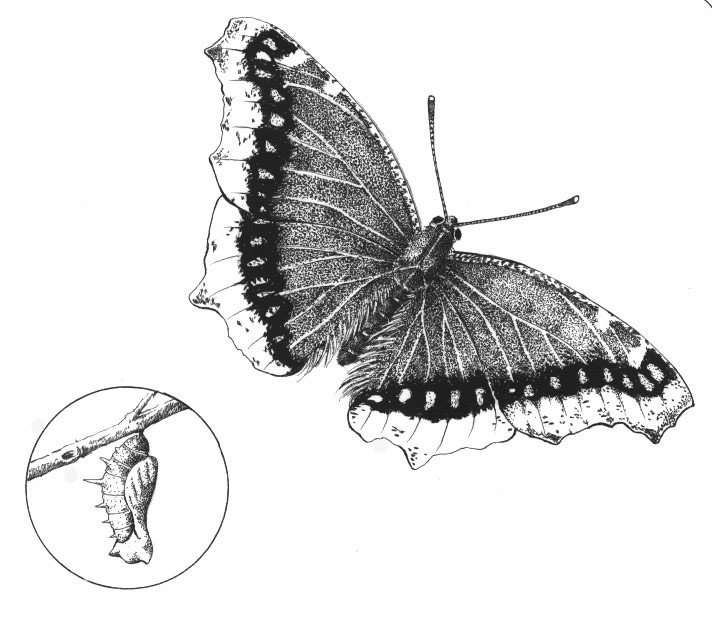
At 5 degrees below zero, butterflies were the last thing on my mind as I brushed the fluffy snow from the porch. But as I swept away the last flakes along the railing, I noticed a small, brown sack about the size of a Tootsie Roll attached to the wood. It was firmly held in place by fine threads. Back inside, with a warm cup of cider and my field guide, I identified it as the chrysalis of a black swallowtail butterfly. Many black swallowtail caterpillars had fed on my dill plants in the nearby garden for most of the late summer. Could this pupa be one of them?
All butterflies develop from egg to larva (caterpillar) to pupa (chrysalis) and finally to the winged adult that we see fluttering around. Each species has evolved a strategy that allows it to successfully survive the winter in one of these four life stages. For example, swallowtails pass the winter in the pupal stage, like the black swallowtail I found on the porch. Skippers – quick little butterflies whose identification can challenge even avid butterfly enthusiasts – spend the winter as caterpillars. The beautiful little coppers and blues remain as eggs through the winter. Monarchs glide to more hospitable temperatures in the south. And some, like the mourning cloak, hunker down and spend the winter as adults.
Most temperate-zone butterflies survive the deep snows and frigid temperatures of New England in a stage called winter diapause, in which metabolic and respiratory rates are low and slow. The cold itself is not a direct hazard to the butterflies – rather, it’s the formation of ice crystals in body tissue that can quickly be lethal. To keep from freezing, butterflies reduce the amount of water in their blood by as much as 30 percent and then thicken it with glycerol, sorbitol, or other antifreeze agents. Mourning cloaks can withstand temperatures down to minus 80 degrees F, but only if they have time to produce these antifreeze agents. If you put a mourning cloak in the freezer on a warm summer day, it will quickly die because it lacks any antifreeze.
Some species of butterflies produce several complete generations each summer, with the last generation entering diapause for the winter. As day length decreases over the summer, it triggers the scheduling of diapause later in the season, either in the insect’s current stage or at a later life-cycle stage. There are more hours of summer sunlight in the northern latitudes than in the southern ones, so northern butterflies must enter diapause earlier to prepare for the earlier onset of winter. Viceroy larvae are programmed to enter diapause after they receive less than 13 hours of daylight in Maryland, 13.5 hours of daylight in Vermont, and 15 hours in Newfoundland.
Butterflies whose eggs overwinter employ one of two strategies. Eggs are laid either on the twigs of host plants, where they remain until larvae emerge in the spring to feed on new leaves, or in the leaf litter at the base of plants whose leaves are destroyed by frost, where the larvae feed on new plant sprouts. Some butterfly species, like the endangered karner blue, rely on an insulating blanket of snow to protect their eggs from harsh weather. When there is little snow, eggs can be damaged by dry, cold air.
Adults that overwinter, such as the mourning cloak or Milbert’s tortoiseshell, store fat in their bodies in the fall. Before entering diapause, they find a place to hide such as a hollow tree or log, a crack in a rock, or inside an old building. In these protected and somewhat insulated hideouts, they enter diapause until the longer and warmer days of spring bring them forth to mate and lay eggs for the next generation. These early spring adults often have wings that are very tattered and ragged from a relatively long life of eight to ten months. Most butterflies spend only a few weeks as adults.
Before breaking diapause in the spring, an individual must first experience a long period of cold weather followed by a longer daylight period. The cold period must be months long to trigger the end of diapause, for if it were shorter, the individual might end diapause during a winter thaw only to be clobbered by the next arctic front.
Beautiful butterflies are still around us, despite this cold, snowy winter. Their special adaptations will enable them to emerge during the warm days of spring. I’ve been watching the little black swallowtail chrysalis on my porch throughout the winter. On the day it bursts from its case and spreads its wings, I’ll know it is truly time to put the snow shovel away and sharpen the garden spade.


Discussion *